2019 TOYOTA LAND CRUISER windshield wipers
[x] Cancel search: windshield wipersPage 3 of 624
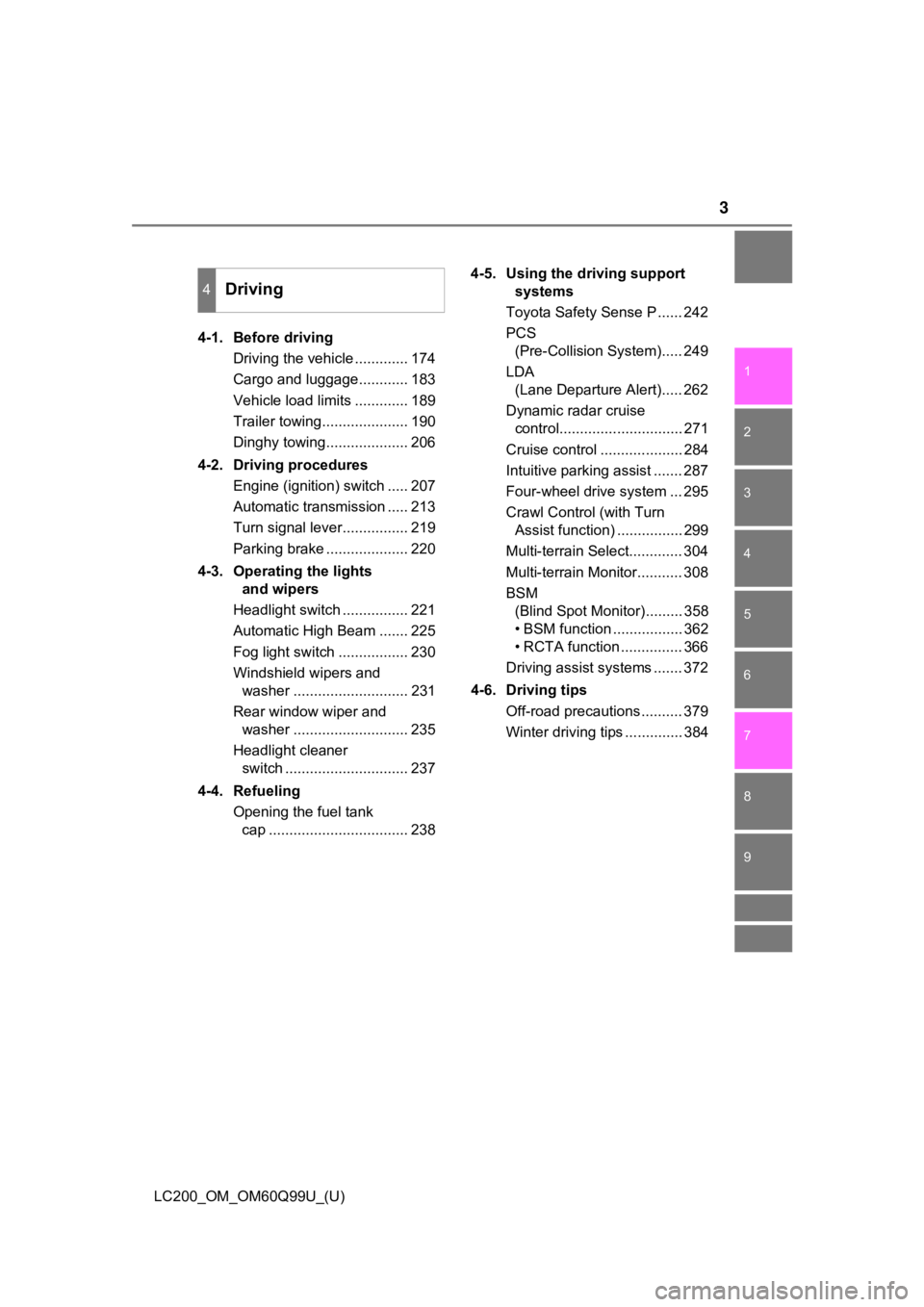
3
1
8 7
6
5
4
3
2
LC200_OM_OM60Q99U_(U)
9
4-1. Before drivingDriving the vehicle ............. 174
Cargo and luggage............ 183
Vehicle load limits ............. 189
Trailer towing..................... 190
Dinghy towing.................... 206
4-2. Driving procedures Engine (ignition) switch ..... 207
Automatic transmission ..... 213
Turn signal lever................ 219
Parking brake .................... 220
4-3. Operating the lights and wipers
Headlight switch ................ 221
Automatic High Beam ....... 225
Fog light switch ................. 230
Windshield wipers and washer ............................ 231
Rear window wiper and washer ............................ 235
Headlight cleaner switch .............................. 237
4-4. Refueling Opening the fuel tank cap .................................. 238 4-5. Using the driving support
systems
Toyota Safety Sense P ...... 242
PCS (Pre-Collision System)..... 249
LDA (Lane Departure Alert)..... 262
Dynamic radar cruise control.............................. 271
Cruise control .................... 284
Intuitive parking assist ....... 287
Four-wheel drive system ... 295
Crawl Control (with Turn Assist function) ................ 299
Multi-terrain Select............. 304
Multi-terrain Monitor........... 308
BSM (Blind Spot Monitor)......... 358
• BSM function ................. 362
• RCTA function ............... 366
Driving assist systems ....... 372
4-6. Driving tips Off-road precautions .......... 379
Winter driving tips .............. 384
4Driving
Page 17 of 624
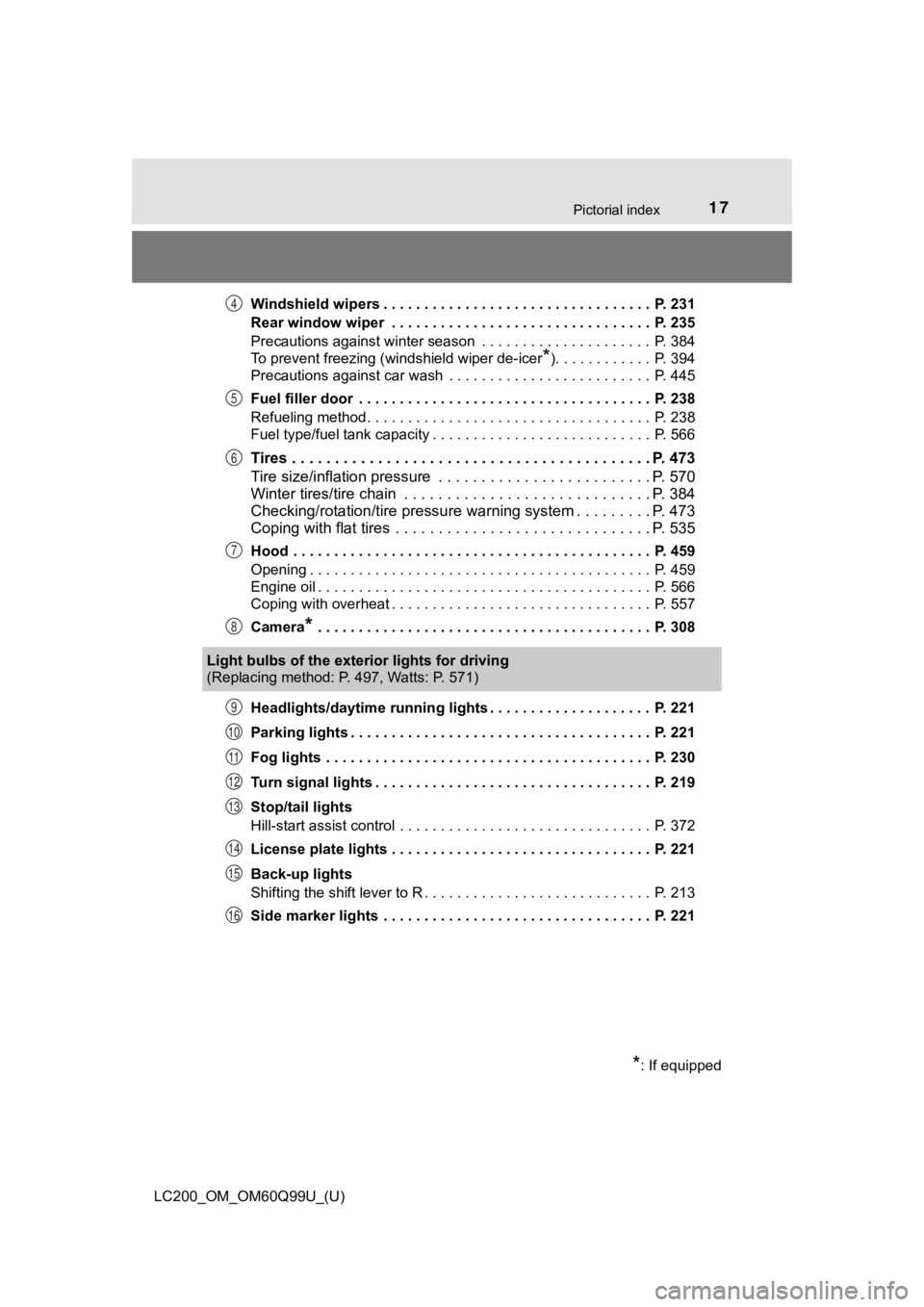
17Pictorial index
LC200_OM_OM60Q99U_(U)Windshield wipers . . . . . . . . . . . . . . . . . . . . . . . . . . . . . . . . . P. 231
Rear window wiper . . . . . . . . . . . . . . . . . . . . . . . . . . . . . . . . P. 235
Precautions against winter season . . . . . . . . . . . . . . . . . . . . . P. 384
To prevent freezing (windshield wiper de-icer
*). . . . . . . . . . . . P. 394
Precautions against car wash . . . . . . . . . . . . . . . . . . . . . . . . . P. 445
Fuel filler door . . . . . . . . . . . . . . . . . . . . . . . . . . . . . . . . . . . . P. 238
Refueling method . . . . . . . . . . . . . . . . . . . . . . . . . . . . . . . . . . . P. 238
Fuel type/fuel tank capacity . . . . . . . . . . . . . . . . . . . . . . . . . . . P. 566
Tires . . . . . . . . . . . . . . . . . . . . . . . . . . . . . . . . . . . . . . . . . . P. 473
Tire size/inflation pressure . . . . . . . . . . . . . . . . . . . . . . . . . P. 570
Winter tires/tire chain . . . . . . . . . . . . . . . . . . . . . . . . . . . . . P. 384
Checking/rotation/tire pressur e warning system . . . . . . . . .P. 473
Coping with flat tires . . . . . . . . . . . . . . . . . . . . . . . . . . . . . . P. 535
Hood . . . . . . . . . . . . . . . . . . . . . . . . . . . . . . . . . . . . . . . . . . . . P. 459
Opening . . . . . . . . . . . . . . . . . . . . . . . . . . . . . . . . . . . . . . . . . . P. 459
Engine oil . . . . . . . . . . . . . . . . . . . . . . . . . . . . . . . . . . . . . . . . . P. 566
Coping with overheat . . . . . . . . . . . . . . . . . . . . . . . . . . . . . . . . P. 557
Camera
* . . . . . . . . . . . . . . . . . . . . . . . . . . . . . . . . . . . . . . . . . P. 308
Headlights/daytime running lights . . . . . . . . . . . . . . . . . . . . P. 221
Parking lights . . . . . . . . . . . . . . . . . . . . . . . . . . . . . . . . . . . . . P. 221
Fog lights . . . . . . . . . . . . . . . . . . . . . . . . . . . . . . . . . . . . . . . . P. 230
Turn signal lights . . . . . . . . . . . . . . . . . . . . . . . . . . . . . . . . . . P. 219
Stop/tail lights
Hill-start assist control . . . . . . . . . . . . . . . . . . . . . . . . . . . . . . . P. 372
License plate lights . . . . . . . . . . . . . . . . . . . . . . . . . . . . . . . . P. 221
Back-up lights
Shifting the shift lever to R . . . . . . . . . . . . . . . . . . . . . . . . . . . . P. 213
Side marker lights . . . . . . . . . . . . . . . . . . . . . . . . . . . . . . . . . P. 221
4
5
6
7
8
Light bulbs of the exterior lights for driving
(Replacing method: P. 497, Watts: P. 571)
*: If equipped
9
10
11
12
13
14
15
16
Page 173 of 624

173
LC200_OM_OM60Q99U_(U)
4Driving
4-1. Before drivingDriving the vehicle ............. 174
Cargo and luggage ........... 183
Vehicle load limits ............. 189
Trailer towing..................... 190
Dinghy towing ................... 206
4-2. Driving procedures Engine (ignition) switch ..... 207
Automatic transmission ..... 213
Turn signal lever................ 219
Parking brake .................... 220
4-3. Operating the lights and wipers
Headlight switch ................ 221
Automatic High Beam ....... 225
Fog light switch ................. 230
Windshield wipers and washer ............................ 231
Rear window wiper and washer ............................ 235
Headlight cleaner switch .............................. 237 4-4. Refueling
Opening the fuel tank cap .................................. 238
4-5. Using the driving support systems
Toyota Safety Sense P ..... 242
PCS (Pre-Collision System) .... 249
LDA (Lane Departure Alert) .... 262
Dynamic radar cruise control ............................. 271
Cruise control .................... 284
Intuitive parking assist....... 287
Four-wheel drive system ... 295
Crawl Control (with Turn Assist function) ............... 299
Multi-terrain Select ............ 304
Multi-terrain Monitor .......... 308
BSM (Blind Spot Monitor) ........ 358
• BSM function ................ 362
• RCTA function .............. 366
Driving assist systems ...... 372
4-6. Driving tips Off-road precautions ......... 379
Winter driving tips ............. 384
Page 223 of 624
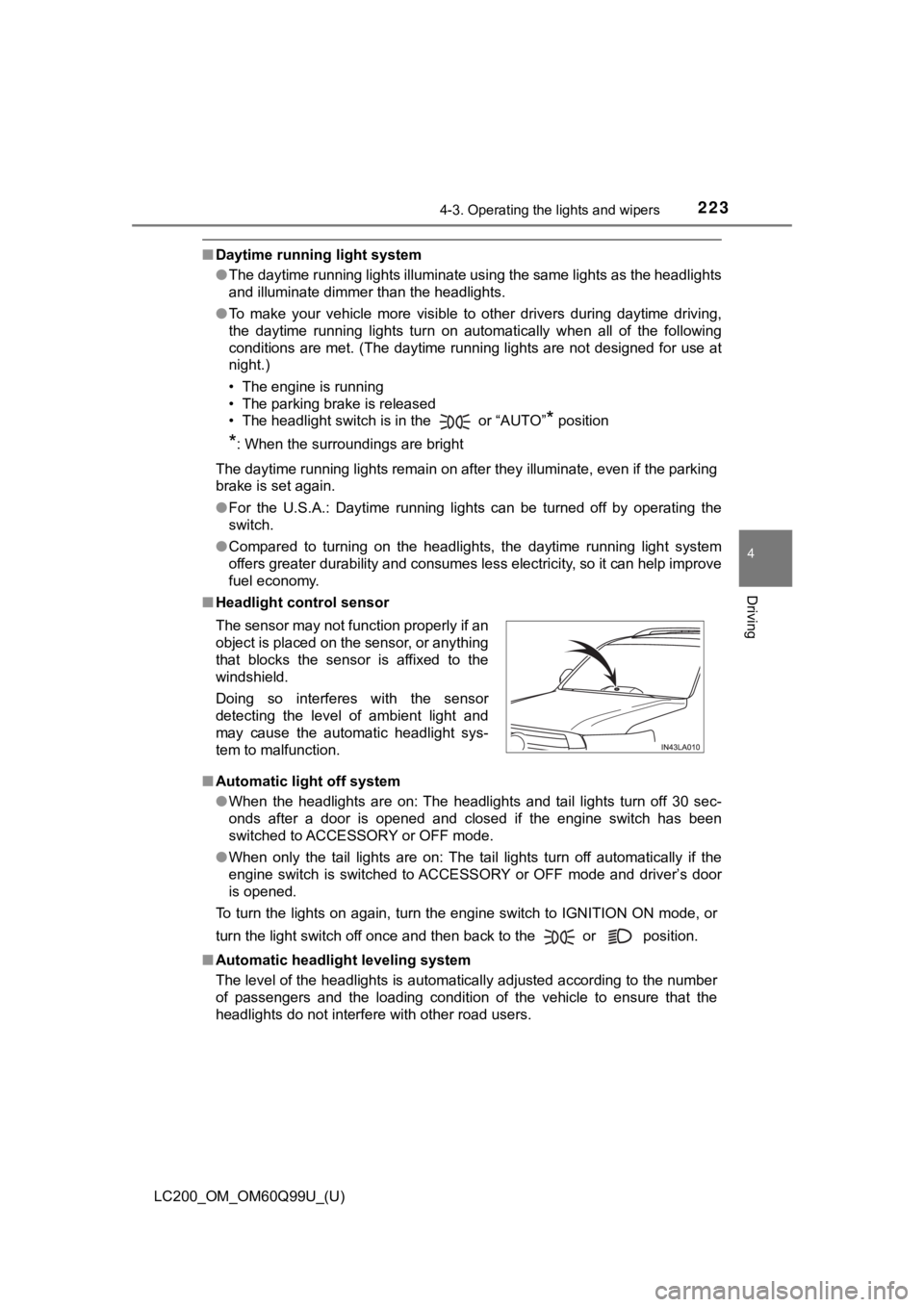
LC200_OM_OM60Q99U_(U)
2234-3. Operating the lights and wipers
4
Driving
■Daytime running light system
●The daytime running lights illuminate using the same lights as the headlights
and illuminate dimmer than the headlights.
● To make your vehicle more visible to other drivers during dayti me driving,
the daytime running lights turn on automatically when all of th e following
conditions are met. (The daytime running lights are not designe d for use at
night.)
• The engine is running
• The parking brake is released
• The headlight switch is in the or “AUTO”
* position
*: When the surroundings are bright
The daytime running lights remain on after they illuminate, even if the parking
brake is set again.
● For the U.S.A.: Daytime running lights can be turned off by ope rating the
switch.
● Compared to turning on the headlights, the daytime running ligh t system
offers greater durability and consumes less electricity, so it can help improve
fuel economy.
■ Headlight control sensor
■ Automatic light off system
●When the headlights are on: The headlights and tail lights turn off 30 sec-
onds after a door is opened and closed if the engine switch has been
switched to ACCESSORY or OFF mode.
● When only the tail lights are on: The tail lights turn off automatically if the
engine switch is switched to ACCESSORY or OFF mode and driver’s door
is opened.
To turn the lights on again, turn the engine switch to IGNITION ON mode, or
turn the light switch off once and then back to the or positi on.
■ Automatic headlight leveling system
The level of the headlights is automatically adjusted according to the number
of passengers and the loading condition of the vehicle to ensur e that the
headlights do not interfere with other road users. The sensor may not function properly if an
object is placed on the sensor, or anything
that blocks the sensor is affixed to the
windshield.
Doing so interferes with the sensor
detecting the level of ambient light and
may cause the automatic headlight sys-
tem to malfunction.
Page 225 of 624
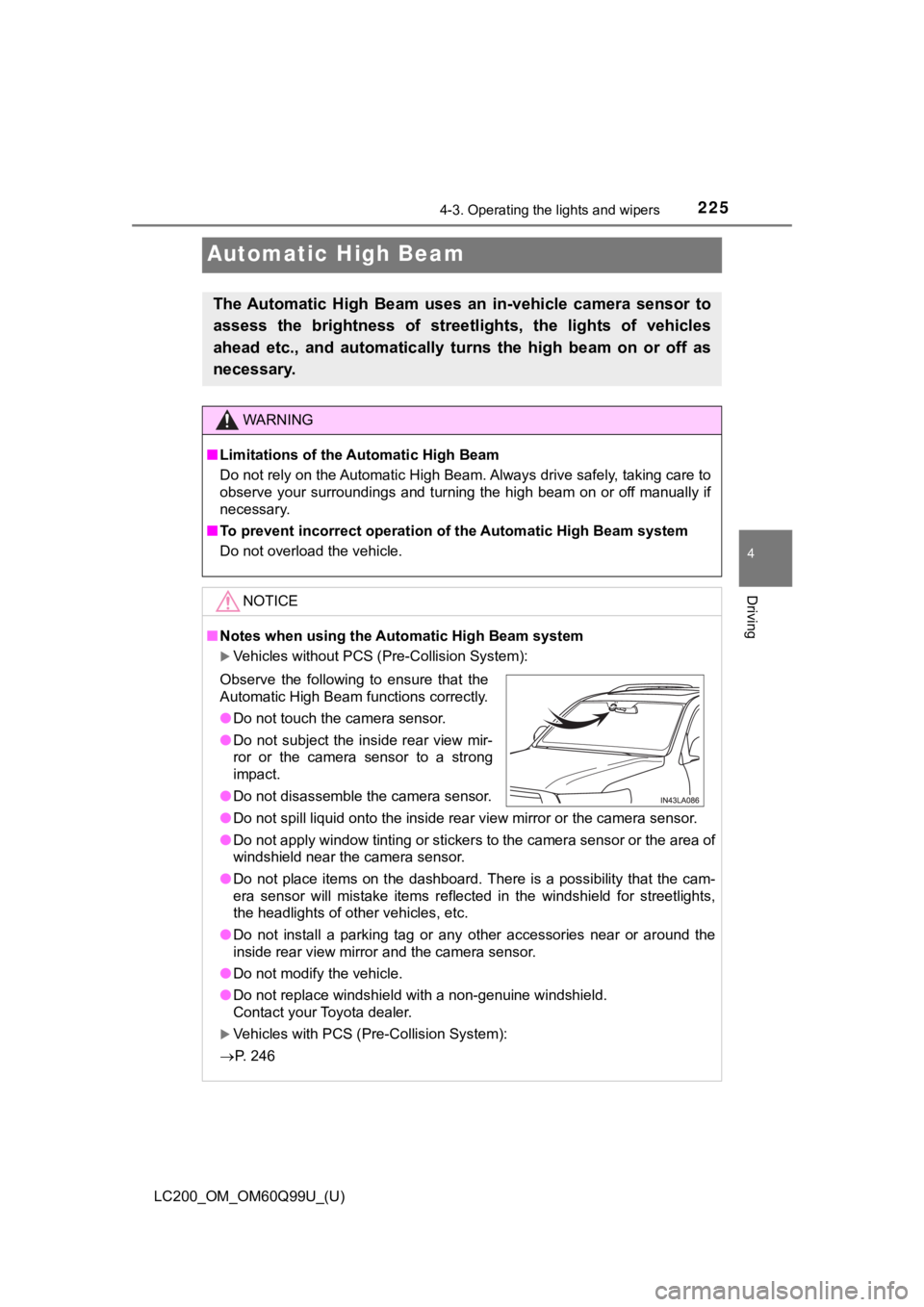
225
LC200_OM_OM60Q99U_(U)
4-3. Operating the lights and wipers
4
Driving
Automatic High Beam
The Automatic High Beam uses an in-vehicle camera sensor to
assess the brightness of streetlights, the lights of vehicles
ahead etc., and automatically turns the high beam on or off as
necessary.
WARNING
■ Limitations of the Automatic High Beam
Do not rely on the Automatic High Beam. Always drive safely, ta king care to
observe your surroundings and turning the high beam on or off m anually if
necessary.
■ To prevent incorrect operation o f the Automatic High Beam syste m
Do not overload the vehicle.
NOTICE
■ Notes when using the Aut omatic High Beam system
Vehicles without PCS (Pre-Collision System):
● Do not spill liquid onto the inside rear view mirror or the cam era sensor.
● Do not apply window tinting or stickers to the camera sensor or the area of
windshield near the camera sensor.
● Do not place items on the dashboard. There is a possibility tha t the cam-
era sensor will mistake items reflected in the windshield for s treetlights,
the headlights of other vehicles, etc.
● Do not install a parking tag or any other accessories near or a round the
inside rear view mirror and the camera sensor.
● Do not modify the vehicle.
● Do not replace windshield with a non-genuine windshield.
Contact your Toyota dealer.
Vehicles with PCS (Pre-Collision System):
P. 246
Observe the following to ensure that the
Automatic High Beam functions correctly.
●Do not touch the camera sensor.
● Do not subject the inside rear view mir-
ror or the camera sensor to a strong
impact.
● Do not disassemble the camera sensor.
Page 228 of 624

228
LC200_OM_OM60Q99U_(U)
4-3. Operating the lights and wipers
●In the situations shown below, the system may not be able to accurately
detect surrounding brightness levels. This may cause the low be ams to
remain on or the high beams to cause problems for pedestrians, vehicles
ahead or other parties. In these cases, manually switch between the high
and low beams.
• In bad weather (rain, snow, fog, sandstorms etc.)
• The windshield is obscured by fog, mist, ice, dirt etc.
• The windshield is cracked or damaged.
• The inside rear view mirror or camera sensor is deformed or di rty.
• The camera sensor temperature is extremely high.
• Surrounding brightness levels are equal to those of headlights , tail lights
or fog lights.
• Vehicles ahead have headlights that are either switched off, d irty, are
changing color, or are not aimed properly.
• When driving through an area of intermittently changing brightness and darkness
• When frequently and repeatedly driving ascending/descending roads, or roads with rough, bumpy or uneven surfaces (such as stone-paved
roads, gravel tracks etc.)
• When frequently and repeatedly taking curves or driving on a w inding
road
• There is a highly reflective object ahead of the vehicle, such as a sign or
a mirror.
• The back of a vehicle ahead is highly reflective, such as a co ntainer on a
truck.
• The vehicle’s headlights are damaged or dirty, or are not aime d properly.
• The vehicle is listing or tilting, due to a flat tire, a trailer being towed etc.
• The high beam and low beam are repeatedly being switched betwe en in
an abnormal manner.
• The driver believes that the high beam may be causing problems or dis-
tress to other drivers or pedestrians nearby.
■ If a warning message of the Aut omatic High Beam is displayed...
It may indicate a malfunction in the system. Contact your Toyota dealer.
Page 231 of 624

231
LC200_OM_OM60Q99U_(U)
4-3. Operating the lights and wipers
4
Driving
Windshield wipers and washer
Operating the lever operates the wipers or washer as follows.
Intermittent windshield wipers with interval adjusterIntermittent operation
Low speed operation
High speed operation
Temporary operation
Wiper intervals can be adjusted when intermittent operation is
selected.
Increases the intermittent
windshield wiper frequency
Decreases the intermittent
windshield wiper frequency
Operating the wiper lever
1
2
3
4
5
6
Page 232 of 624
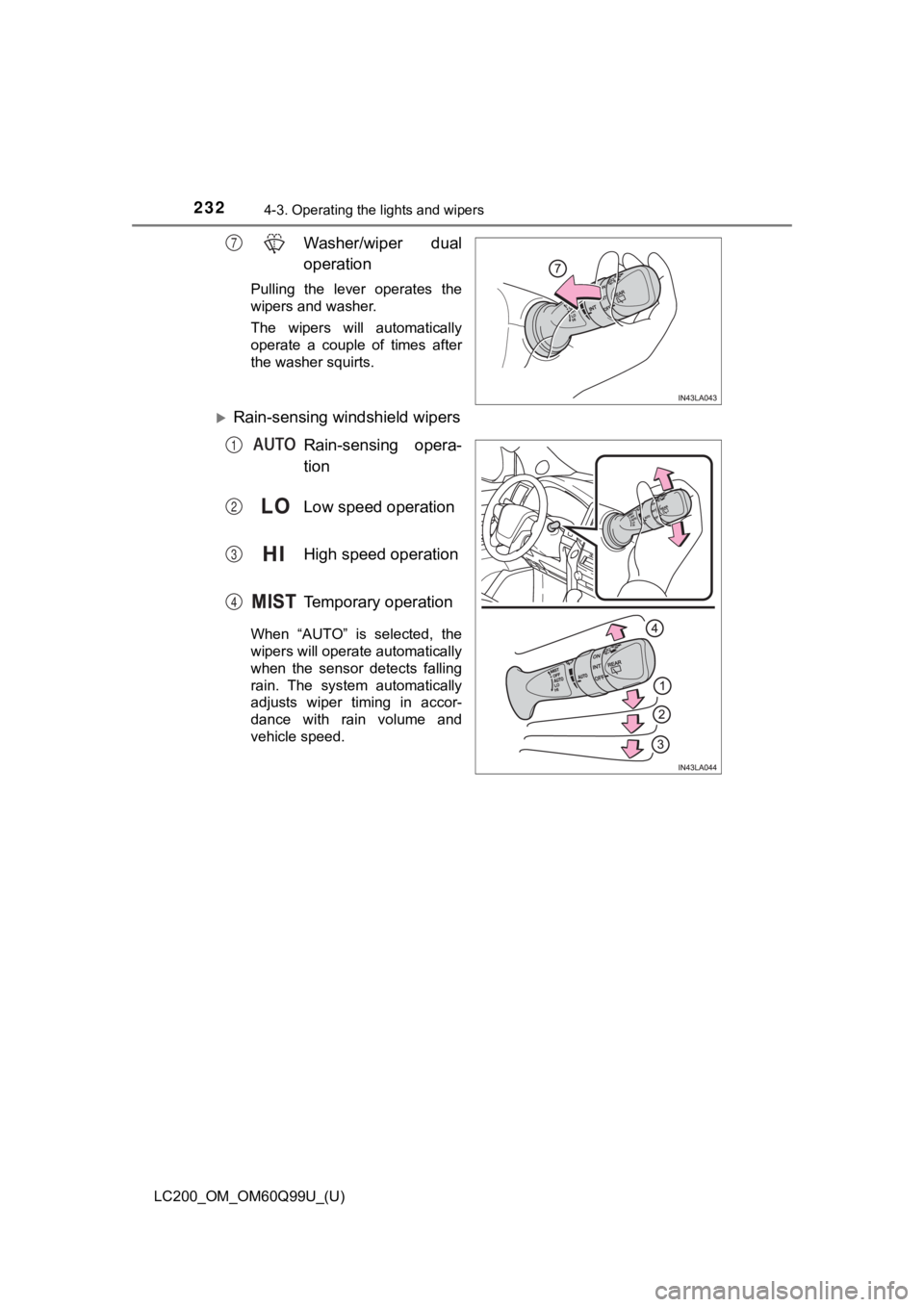
232
LC200_OM_OM60Q99U_(U)
4-3. Operating the lights and wipers
Washer/wiper dual
operation
Pulling the lever operates the
wipers and washer.
The wipers will automatically
operate a couple of times after
the washer squirts.
Rain-sensing windshield wipersRain-sensing opera-
tion
Low speed operation
High speed operation
Temporary operation
When “AUTO” is selected, the
wipers will operate automatically
when the sensor detects falling
rain. The system automatically
adjusts wiper timing in accor-
dance with rain volume and
vehicle speed.
7
1
2
3
4